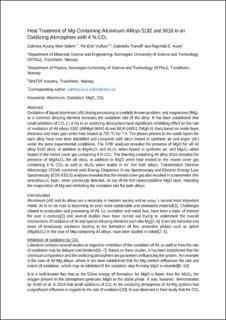Heat Treatment of Mg-Containing Aluminum Alloys 5182 and 6016 in an Oxidizing Atmosphere with 4% CO2
Peer reviewed, Journal article
Accepted version

View/
Date
2022Metadata
Show full item recordCollections
- Institutt for fysikk [2652]
- Institutt for materialteknologi [2496]
- Publikasjoner fra CRIStin - NTNU [37215]
Abstract
Oxidation of liquid aluminum (Al) during processing is a widely known problem, and magnesium (Mg), as a common alloying element, increases the oxidation rate of the alloy. It has been established that small additions of CO2 (≥ 4%) in an oxidizing atmosphere have a significant inhibiting effect on the rate of oxidation of Al alloys 5182 (AlMg4.5Mn0.4) and 6016 (AlSi1.2Mg0.4) discs based on oxide layer thickness and mass gain when heat-treated at 750 °C for 7 h. The phases present in the oxide layers for each alloy have now been identified and compared with discs heated in synthetic air and argon (Ar) under the same experimental conditions. The XRD analyses revealed the presence of MgO for all Al alloy 5182 discs, in addition to MgAl2O4 and Al2O3 when heated in synthetic air, and Mg2C3 when heated in the mixed cover gas containing 4% CO2. The low Mg-containing Al alloy 6016 revealed the presence of MgAl2O4 for all discs, in addition to MgO when heat-treated in the mixed cover gas containing 4% CO2, as well as Al2O3 when heated in Ar. For both alloys, Transmission Electron Microscopy (TEM) combined with Energy Dispersive X-ray Spectroscopy and Electron Energy Loss Spectroscopy (EDS-EELS) analyses revealed that the mixed cover gas also resulted in a nanometer-thin amorphous C layer, never previously detected, on top of the thin nanocrystalline MgO layer, retarding the evaporation of Mg and inhibiting the oxidation rate for both alloys.